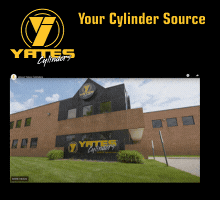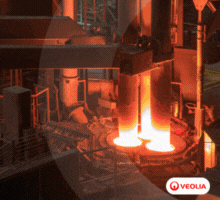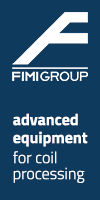AK Steel's Quarterly Results Impacted by Weather, Furnace Outage
04/22/2014 - AK Steel day reported its financial results for the first quarter of 2014.
1st Quarter 2014 Performance Summary
Net sales for the first quarter of 2014 were US$1.38 billion on shipments of 1,262,100 tons, compared to net sales of US$1.37 billion on shipments of 1,289,800 tons for the year-ago first quarter and net sales of US$1.46 billion on shipments of 1,420,000 tons for the fourth quarter of 2013. The reduction in shipments in the first quarter of 2014 compared to the fourth quarter of 2013 was primarily due to the effects of the previously disclosed unplanned outage at the company's Ashland Works blast furnace discussed below. The overall reduction reflects a decline in shipments of electrical steel and of carbon steel to the spot market, partially offset by higher automotive shipments.
The company said its average selling price for the first quarter of 2014 was US$1,096 per ton, a 3% increase from the first quarter of 2013 and an increase of 6% from the fourth quarter of 2013. The increase in average selling price is principally due to a richer shipment mix of value-added products.
The company incurred higher production costs in the first quarter of 2014 due to several significant factors. The extreme cold weather conditions in the United States during the first quarter of 2014 affected operations and caused severe spikes in energy costs. As a result, the company's costs for natural gas and electricity were approximately US$30.0 million higher than they were for the first quarter of 2013 and approximately US$27.0 million higher than they were for the fourth quarter of 2013.
Another major driver of the company's higher production costs for the 2014 first quarter was the previously disclosed incident at the company's Ashland Works blast furnace. That incident occurred in late February and resulted in a temporary unplanned outage of the Ashland Works blast furnace. The company immediately began repairs and the blast furnace resumed operations in March. The company incurred approximately US$18.0 million in costs during the first quarter of 2014 as a result of this unplanned outage.
In addition, the company incurred US$29.4 million for planned outage costs during the first quarter of 2014, compared to US$1.0 million in the year-ago first quarter and US$1.5 million in the fourth quarter of 2013. The higher planned outage costs in the first quarter of 2014 include the acceleration of the majority of a previously disclosed planned maintenance outage at Ashland Works that had been originally scheduled for the second quarter of 2014. The company does not have any significant outages planned for the remainder of 2014.
The company also incurred higher costs for iron ore and carbon scrap during the first quarter of 2014 compared to the fourth quarter of 2013. In addition, during the first quarter of 2014, the company incurred a charge of US$5.8 million relating to a tentative settlement of certain class action antitrust claims. The settlement remains subject to court approval. The company believes that the claims asserted against it lack merit, but it elected to enter into a settlement in order to avoid the ongoing expense of defending itself in protracted and expensive antitrust litigation.
The 2014 first quarter results included a LIFO credit of US$1.5 million, compared to a LIFO credit of US$6.0 million in the first quarter of 2013 and a LIFO credit of US$4.3 million for the fourth quarter of 2013.
"Our first quarter results were negatively impacted by extreme cold weather in the U.S., as well as planned and unplanned outages at our Ashland Works," said James L. Wainscott, Chairman, President and CEO of AK Steel. "Having worked through those challenges, we believe that AK Steel is well-positioned for a much improved second quarter."
Liquidity
In March 2014, AK Steel entered into a new US$1.1 billion asset-backed revolving credit facility with a group of lenders. The new credit facility, which expires in March 2019, replaced AK Steel's prior US$1.1 billion asset-backed revolving credit facility, which was set to expire in April 2016, and is secured by the same classes of assets as the replaced credit facility. The new credit facility provides the company with enhanced liquidity and greater financial and strategic flexibility. The company ended the first quarter of 2014 with total liquidity of US$786.8 million consisting of cash and cash equivalents and US$757.0 million of availability under the company's revolving credit facility.
Second Quarter 2014 Outlook
Consistent with its current practice, the company expects to provide detailed guidance for its second quarter results in June.
- Shipments of 1,262,100 tons
- Sales of US$1.38 billion with an average selling price of US$1,096 per ton
- Net after-tax loss of US$86.1 million, or US$0.63 per diluted share
- Adjusted net after-tax loss of US$54.4 million, or US$0.40 per diluted share, for adjustment of non-cash income tax charge
- Completed a new US$1.1 billion credit facility expiring in 2019
- Ended 1Q with strong liquidity of approximately US$787 million
Net sales for the first quarter of 2014 were US$1.38 billion on shipments of 1,262,100 tons, compared to net sales of US$1.37 billion on shipments of 1,289,800 tons for the year-ago first quarter and net sales of US$1.46 billion on shipments of 1,420,000 tons for the fourth quarter of 2013. The reduction in shipments in the first quarter of 2014 compared to the fourth quarter of 2013 was primarily due to the effects of the previously disclosed unplanned outage at the company's Ashland Works blast furnace discussed below. The overall reduction reflects a decline in shipments of electrical steel and of carbon steel to the spot market, partially offset by higher automotive shipments.
The company said its average selling price for the first quarter of 2014 was US$1,096 per ton, a 3% increase from the first quarter of 2013 and an increase of 6% from the fourth quarter of 2013. The increase in average selling price is principally due to a richer shipment mix of value-added products.
The company incurred higher production costs in the first quarter of 2014 due to several significant factors. The extreme cold weather conditions in the United States during the first quarter of 2014 affected operations and caused severe spikes in energy costs. As a result, the company's costs for natural gas and electricity were approximately US$30.0 million higher than they were for the first quarter of 2013 and approximately US$27.0 million higher than they were for the fourth quarter of 2013.
Another major driver of the company's higher production costs for the 2014 first quarter was the previously disclosed incident at the company's Ashland Works blast furnace. That incident occurred in late February and resulted in a temporary unplanned outage of the Ashland Works blast furnace. The company immediately began repairs and the blast furnace resumed operations in March. The company incurred approximately US$18.0 million in costs during the first quarter of 2014 as a result of this unplanned outage.
In addition, the company incurred US$29.4 million for planned outage costs during the first quarter of 2014, compared to US$1.0 million in the year-ago first quarter and US$1.5 million in the fourth quarter of 2013. The higher planned outage costs in the first quarter of 2014 include the acceleration of the majority of a previously disclosed planned maintenance outage at Ashland Works that had been originally scheduled for the second quarter of 2014. The company does not have any significant outages planned for the remainder of 2014.
The company also incurred higher costs for iron ore and carbon scrap during the first quarter of 2014 compared to the fourth quarter of 2013. In addition, during the first quarter of 2014, the company incurred a charge of US$5.8 million relating to a tentative settlement of certain class action antitrust claims. The settlement remains subject to court approval. The company believes that the claims asserted against it lack merit, but it elected to enter into a settlement in order to avoid the ongoing expense of defending itself in protracted and expensive antitrust litigation.
The 2014 first quarter results included a LIFO credit of US$1.5 million, compared to a LIFO credit of US$6.0 million in the first quarter of 2013 and a LIFO credit of US$4.3 million for the fourth quarter of 2013.
"Our first quarter results were negatively impacted by extreme cold weather in the U.S., as well as planned and unplanned outages at our Ashland Works," said James L. Wainscott, Chairman, President and CEO of AK Steel. "Having worked through those challenges, we believe that AK Steel is well-positioned for a much improved second quarter."
Liquidity
In March 2014, AK Steel entered into a new US$1.1 billion asset-backed revolving credit facility with a group of lenders. The new credit facility, which expires in March 2019, replaced AK Steel's prior US$1.1 billion asset-backed revolving credit facility, which was set to expire in April 2016, and is secured by the same classes of assets as the replaced credit facility. The new credit facility provides the company with enhanced liquidity and greater financial and strategic flexibility. The company ended the first quarter of 2014 with total liquidity of US$786.8 million consisting of cash and cash equivalents and US$757.0 million of availability under the company's revolving credit facility.
Second Quarter 2014 Outlook
Consistent with its current practice, the company expects to provide detailed guidance for its second quarter results in June.



.jpg?lang=en-US&ext=.jpg)
-(1).gif?width=220&height=200&mediaprotectionhash=8011a71ede637cd523c67b1296fc49e6151560fde821a46f29cc85998cc76615&ext=.gif)


